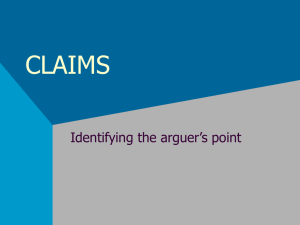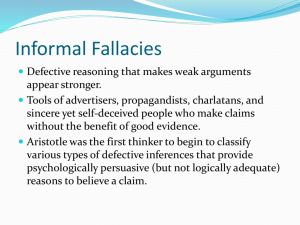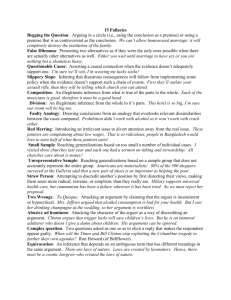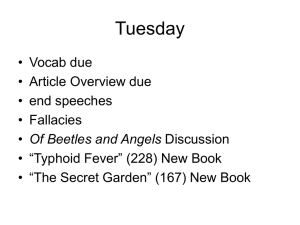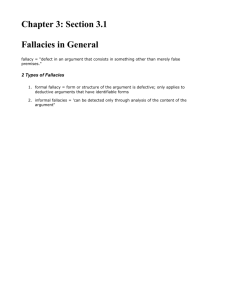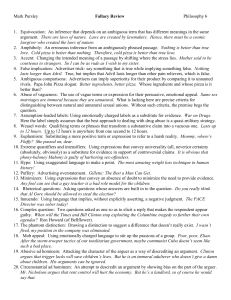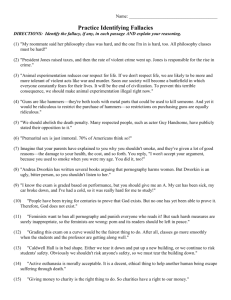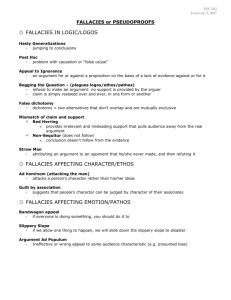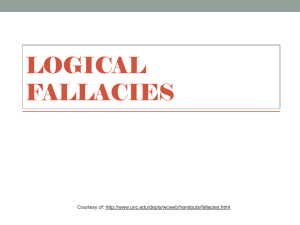File
advertisement
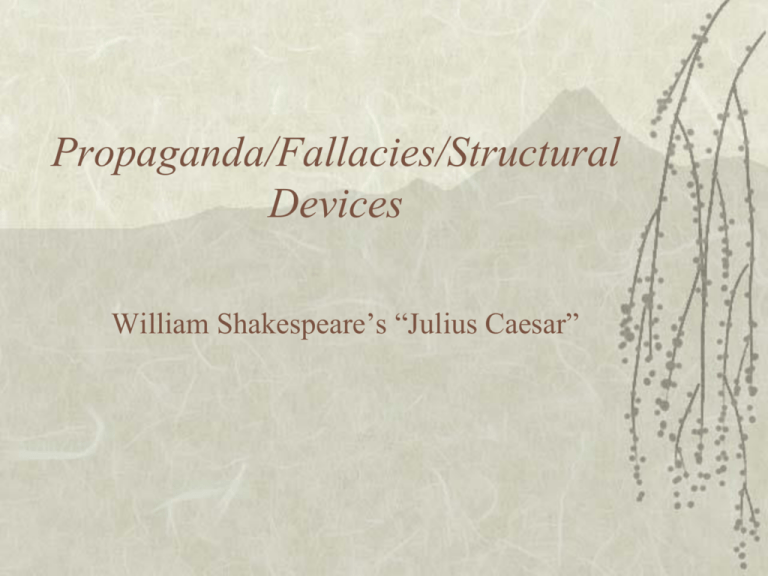
Propaganda/Fallacies/Structural Devices William Shakespeare’s “Julius Caesar” What is propaganda? This is information, ideas, or rumors deliberately spread widely to help or harm a person, group, movement, institution, nation, etc – Think of the commercials you watch on tv, read in a magazine, or listen to on the radio…all of these have propaganda techniques that are going to try to get you to buy that product What is a Fallacy? A fallacy is an argument that is flawed by its very nature or structure Fallacies are not absolute Depending on context, some fallacies can be appropriate to certain situations What are Structural Devices? These are some of the literary devices we will see in the play – Rhetorical questions – Antiphrasis which forms a good deal of casual speech…example “That is one bad*** movie” you are saying it is a good movie – Asyndeton eliminates conjunctions in sentences while still maintaining grammatical accuracy Hasty Generalization An inference drawn from insufficient evidence Example: – Four Arab fundamentalists were convicted in the bombing of the WTC – Arabs are nothing but a pack of religious fanatics prone to violence Dicto Simpliciter (Sweeping Generalization) Making a sweeping statement and expecting it to be true of every specific case – Stereotyping Post Hoc Ergo Propter Hoc After this, therefore because of this) Suggests that because B follows A, A must cause B. Remember, just because two events or two sets of data are related does not necessarily mean that one caused the other to happen. It is important to evaluate data carefully before jumping to a wrong conclusion. Ad Baculum Someone resorts to force or threat of force to try to push others to accept a conclusion Ad Hominem “To the man” Assaulting a person’s character, rather then the logic of his/her argument Tu Quoque “You, too!” Argument, the arguer points out that the opponent has actually done the thing he or she is arguing against, and so the opponent's argument shouldn't be listened to. Ad Lazarum Assumes that someone who is poor is sounder or more virtuous than someone who is wealthier Example: “Monks are more likely to possess insight into the meaning of life, as they have given up the distractions of wealth. Ad Misericordiam (Appeal to pity) The appeal to pity takes place when an arguer tries to get people to accept a conclusion by making them feel sorry for someone. Ad Populum Means "to the people." The arguer takes advantage of the desire most people have to be liked and to fit in with others Uses that desire to try to get the audience to accept his or her argument. Ad Verecumdiam (Appeal to Authority) Referring to respected sources or authorities and explaining their positions on the issues being discussed. Trying to get readers to agree with us simply by impressing them with a famous name or by appealing to a supposed authority who really isn't much of an expert Non Sequitur The logic of the argument is not connected: Example: I stole the lipstick because the sky was blue. Missing the Point The premises of an argument do support a particular conclusion, but not the conclusion that the arguer actually draws. Slippery Slope Threatens successively amplified consequences for small actions Weak (False)Analogy Comparisons that are inappropriate or inaccurate Appeal to Ignorance In the appeal to ignorance, the arguer basically says, "Look, there's no conclusive evidence on the issue at hand. Therefore, you should accept my conclusion on this issue.“ Example: "People have been trying for centuries to prove that God exists. But no one has yet been able to prove it. Therefore, God does not exist." Straw Man Anticipate and respond in advance to the arguments that an opponent might make. The arguer sets up a wimpy version of the opponent's position and tries to score points by knocking it down. But just as being able to knock down a straw man, or a scarecrow, isn't very impressive Defeating a watered-down version of your opponents' argument isn't very impressive either. Red Herring Partway through an argument, the arguer goes off on a tangent, raising a side issue that distracts the audience from what's really at stake. Often, the arguer never returns to the original issue. False Dichotomy The arguer sets up the situation so it looks like there are only two choices. The arguer then eliminates one of the choices, so it seems that we are left with only one option: the one the arguer wanted us to pick in the first place. But often there are really many different options, not just two—and if we thought about them all, we might not be so quick to pick the one the arguer recommends! Begging the Question Assuming as true the very claim that is being disputed Equivocation A half-truth, usually involving a trick of language Example: “none of woman born/shall harm Macbeth” Either/Or Technique is also called "black-and-white thinking" because only two choices are given. You are either for something or against it; there is no middle ground or shades of gray. It is used to polarize issues, and negates all attempts to find a common ground. False Authority Offering an authority as sufficient warrant for believing a claim Example: – X is true because I, George Washington say(s) it is Propaganda Techniques Name Calling Attaching a negative label to a person or a thing. People engage in this type of behavior when they are trying to avoid supporting their own opinion with facts. Rather than explain what they believe in, they prefer to try to tear their opponent down. Glittering Generalities Uses important-sounding "glad words" that have little or no real meaning. These words are used in general statements that cannot be proved or disproved. Words like "good," "honest," "fair," and "best" are examples of "glad" words. Transfer An attempt is made to transfer the prestige of a positive symbol to a person or an idea. For example, using the American flag as a backdrop for a political event makes the implication that the event is patriotic in the best interest of the U.S. Testimonial It is when "big name" personalities are used to endorse a product. Whenever you see someone famous endorsing a product, ask yourself how much that person knows about the product, and what he or she stands to gain by promoting it. Plain Folks Uses a folksy approach to convince us to support someone or something. These ads depict people with ordinary looks doing ordinary activities. Card Stacking This term comes from stacking a deck of cards in your favor. Card stacking is used to slant a message. Key words or unfavorable statistics may be omitted in an ad or commercial, leading to a series of half-truths. Keep in mind that an advertiser is under no obligation "to give the truth, the whole truth, and nothing but the truth." Bandwagon Encourages you to think that because everyone else is doing something, you should do it too, or you'll be left out. The technique embodies a "keeping up with the Joneses" philosophy. Snob Appeal Arouses the desire to achieve status or wealth or to feel superior. Loaded Words Using words with strong connotations -whether negative or positive. Source Documentation <www.cwrl.utexas.edu/~ulrich/presentations/fallacies.ppt> Rhetorical Appeals Works Cited <http://rhetoric.byu.edu/Persuasive%20Appeals/Persuasive%20A ppeals.htm> Fallacies Works Cited <http://www.unc.edu/depts/wcweb/handouts/fallacies.html> Works Consulted Hurley, Patrick J. A Concise Introduction to Logic. Thornson Learning, 2000 Lunsford, Andrea and John Ruszkiewicz. Everything's an Argument. Bedford Books, 1998. Copi, Irving M. and Carl Cohen. Introduction to Logic. Prentice Hall, 1998. Propaganda Works Cited <http://academic.cuesta.edu/acasupp/as/404.htm>
